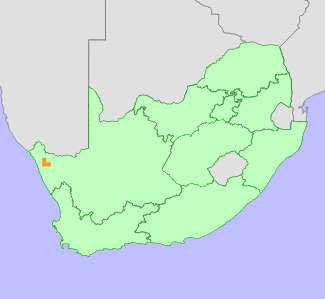|
Scientific Name | Conophytum obscurum N.E.Br. subsp. sponsaliorum (S.A.Hammer) S.A.Hammer |
Higher Classification | Dicotyledons |
Family | AIZOACEAE |
Synonyms | Conophytum bachelorum S.A.Hammer subsp. sponsaliorum S.A.Hammer |
National Status |
Status and Criteria | Critically Endangered A4d |
Assessment Date | 2021/12/01 |
Assessor(s) | A.J. Young, P.G. Desmet, I. Ebrahim, D. Guo, A. Harrower, L. Jabar, L. Knoetze, C. Rodgerson, P.C.V. Van Wyk & N.N. Mhlongo |
Justification | This succulent is endemic to the Northern Cape province of South Africa with an extent of occurrence (EOO) of 106 km2 and area of occupancy (AOO) of 24 km2. The plants are only recorded from four locations and the population is in decline due to illegal collection for the ornamental succulent plant trade, with collection likely to increase as there has been a dramatic increase in the number of species and volume of plants targeted since 2019. The continued threat of illegal collection is therefore regarded as very high for this particular taxon. The limited number of known locations and relatively small population size is suspected to result in a decline of over 80% of the population within the next three generations (90 years). Climate change is also impacting the population, with loss of vegetation cover already causing ongoing decline in habitat quality. The rapid declines to the population as a result of illegal collection means it qualifies as Critically Endangered under criterion A4. |
Distribution |
Endemism | South African endemic |
Provincial distribution | Northern Cape |
Range | This succulent is endemic to the Northern Cape province of South Africa where it is has a restricted geographic range and is known from only four locations. |
Habitat and Ecology |
Major system | Terrestrial |
Major habitats | Southern Richtersveld Inselberg Shrubland, Namaqualand Klipkoppe Shrubland |
Description | This succulent is endemic to Namaqualand Klipkoppe Shrubland in the Namaqualand Hardeveld bioregion of the Succulent Karoo biome. The plants are found both on sheltered quartz rock faces (in cracks and crevices) or in more exposed areas in shallow quartz grit-filled pans.
This taxon has a generation length of 30 years. It is expected to be sensitive to the impacts of climate change as it does not disperse and while adapted to arid conditions, is dependent on limited seasonal rainfall. Species in the genus are sensitive to long periods of drought. Drought related mortality has been observed for other closely related taxa within the genus. |
Threats |
| This succulent has been subject to illegal collection for the international trade in ornamental succulents and the population is in decline. This is likely to increase in future as there has been a dramatic increase in the number of species and volume of plants targeted since 2019. As a result a population decline of 60-85% is suspected over three generations (90 years). Anthropogenic climate change is a long-term threat to this taxon. Loss of vegetation cover has been observed across the geographic range occupied by this taxon via Landsat imagery between 1984 and 2018 indicating a decline in habitat quality. Climate models for the likely emission scenarios where emissions stay at present day levels (RCP 2.6) (Hausfather and Peters 2020) and worst case scenarios where emissions continue to increase during the 21st century (RCP 8.5) indicate that there will be a loss of suitable bioclimatic envelope of between 24% and 26% by 2080 for this taxon. Species in this genus have limited dispersal ability and migration to suitable habitats elsewhere is regarded as highly unlikely. |
Population |
It is found in four subpopulations where it is often locally abundant. There are no formal estimates of population size for this taxon but the number of mature individuals is probably less than 10,000. The population is experiencing initial levels of decline due to illegal collection for the ornamental succulent plant trade.
|
Population trend | Decreasing |
Assessment History |
Taxon assessed |
Status and Criteria |
Citation/Red List version | | Conophytum obscurum N.E.Br. subsp. sponsaliorum (S.A.Hammer) S.A.Hammer | Rare | 2015.1 | | Conophytum obscurum N.E.Br. subsp. sponsaliorum (S.A.Hammer) S.A.Hammer | Least Concern | Raimondo et al. (2009) | |
Bibliography |
Hammer, S. 2002. Dumpling and his wife: New view of the genus Conophytum. EAE Creative Colour, Norwich.
Hammer, S.A. 1993. The genus Conophytum: A conograph. Succulent Plant Publications, Pretoria.
Hausfather, Z. and Peters, G.P. 2020. Emissions - the 'business as usual' story is misleading. Nature 577(618-620).
Opel, M.R. 2004. The rediscovery of Crassula alcicornis. Haseltonia 10:38-40.
|
Citation |
| Young, A.J., Desmet, P.G., Ebrahim, I., Guo, D., Harrower, A., Jabar, L., Knoetze, L., Rodgerson, C., Van Wyk, P.C.V. & Mhlongo, N.N. 2021. Conophytum obscurum N.E.Br. subsp. sponsaliorum (S.A.Hammer) S.A.Hammer. National Assessment: Red List of South African Plants version 2024.1. Accessed on 2025/12/13 |
 Comment on this assessment
Comment on this assessment


